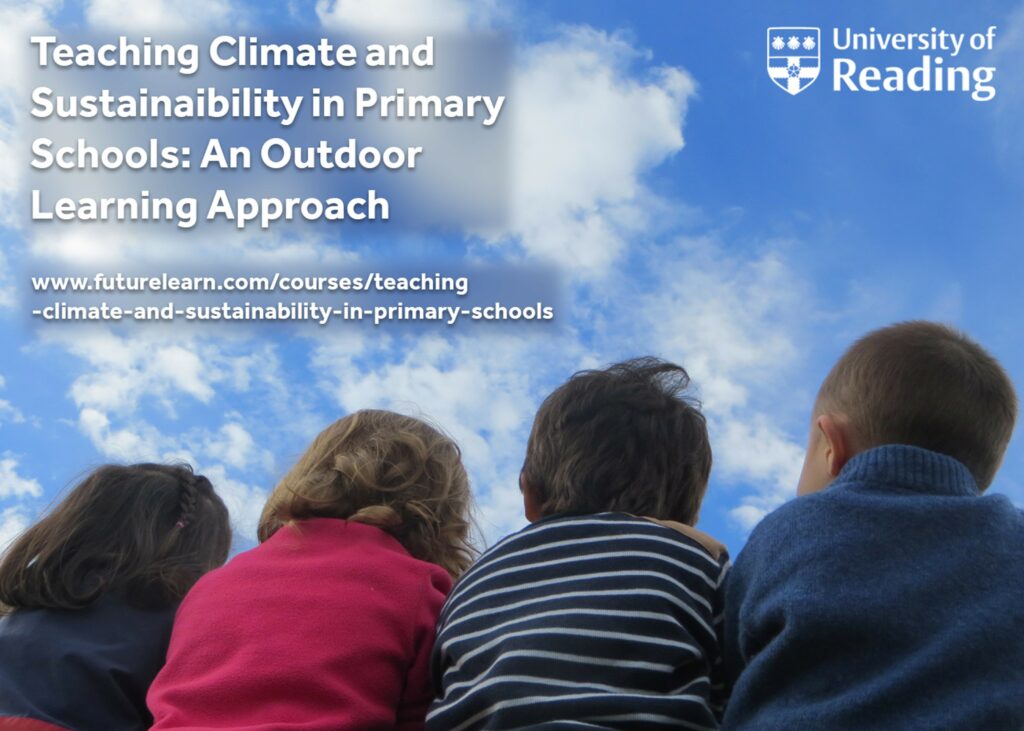Last week we launched a short online course on Teaching Climate and Sustainability in Primary Schools: An Outdoor Learning Approach on the FutureLearn platform. The course is for Primary teachers who are concerned about our planet and want to take action by embedding these vital topics into their teaching. We hope it will be particularly beneficial for teachers who are leading climate and sustainability initiatives in their schools or looking for opportunities to build their confidence for such a role in the future.

Teaching about climate and sustainability
In recent months the debate about the need to improve climate education has been growing. Our course doesn’t provide teachers with a blueprint for teaching climate and sustainability. Rather, we wanted to provide the space for teachers to discuss examples from the case study school we feature in the course and to share their own experiences and ideas. In this way we are hoping to build a body of knowledge that can be more widely shared.
Learning about the environment in the environment
There are now a large number of courses about climate, but none from the perspective of learning and teaching outdoors. So this course is unique. This surprises me because, as I tweeted, a while ago: “To care for the world, you need to love it. To love it, you need to be a part of it. To be a part of it, you need to spend lots of time out in it. In this way you can appreciate the world’s power and fragility”. It seems totally logical (to me) that anyone will only learn about climate and sustainability if they are in the world, in nature, outside. So children must be allowed to learn in the outdoor environment.
Learning is about gaining knowledge, skills, understanding and attitudes. Although you might be able to improve knowledge about the climate and sustainability by teaching it inside a room, you are unlikely to change attitudes or real understanding, let alone teach skills indoors. Because what is needed is behavioural change. Both COP26 and the forthcoming COP27 later this year emphasise the urgent need to change the behaviours of big business as well as every one of us in our day-to-day lives.
UNESCO urges that environmental education should be a core curriculum component in all countries by 2025. Its 2021 report Learn from our Planet states: “Environmental learning should be integrated across the curriculum, with a holistic pedagogy that goes beyond an exclusive cognitive knowledge focus and aims to engage students, socially, emotionally and in action-orientated learning and participation” (p.37).
In other words, learning about the world should not come under one curriculum area and should impact the whole child – cognitively, socially, emotionally – and this can only be done if children are ac tively doing something. Doing something means real experiences: planting, tending and eating vegetables, making compost from the waste food in the school, adopting and caring for a tree, simply being taught outside.
Why can’t you learn outside?
My first lecture as a trainee teacher was on what was then called the nursery school garden. I have been hooked ever since on the power of the outdoor teaching and learning environment. However, it’s been a battle for my whole professional life. As Tina Bruce, an Early Years guru said back in 1987: “Frequent lack of attention to the external environment must come from some bizarre assumption that knowledge acquired indoors is superior to that gained outside” (Early Childhood Education, p.55).
I hope that our growing concern about the climate and our environment will finally convince all that outside is a great place to teach and learn. And indeed, is and the only place to teach and learn about the world.
Helen Bilton is Professor of Outdoor Learning and Play in the Institute of Education. Her research focuses on the environment for learning and teaching, early years education for 3- to 5-year-olds, and outdoor play and provision for the early years and primary.
The free online course on Teaching Climate and Sustainability in Primary Schools: An Outdoor Learning Approach is provided via FutureLearn.

